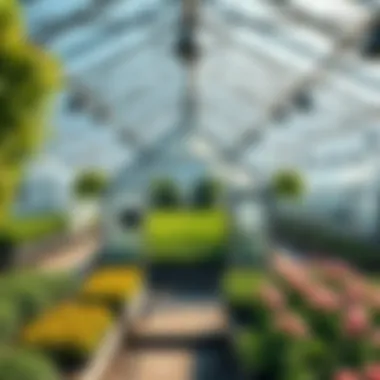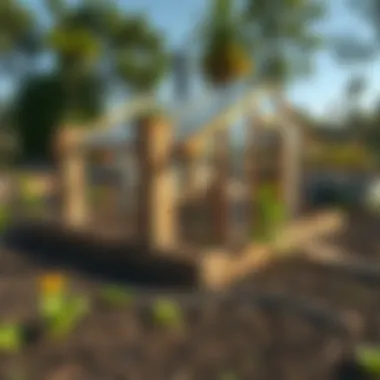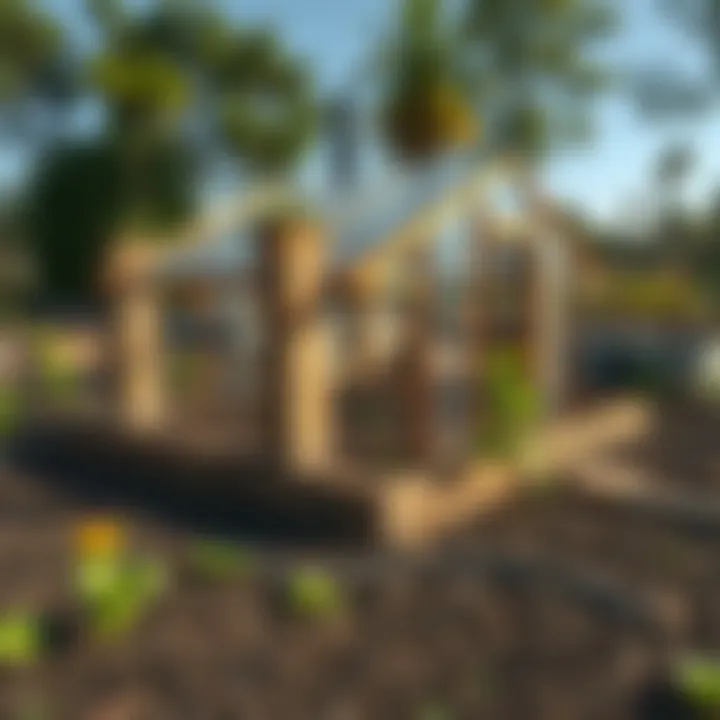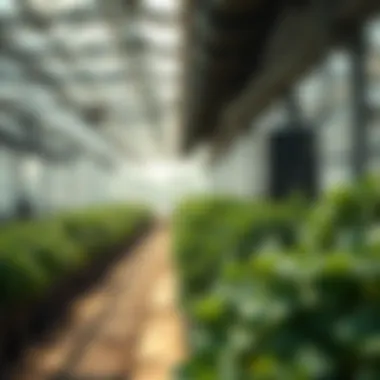A Complete Guide to Building Your Greenhouse


Intro
Creating a greenhouse can transform your gardening experience, offering a controlled environment for your plants to thrive. This guide will delve into the essential elements of assembling a greenhouse, catering to both novices and seasoned agricultural enthusiasts. Whether you aim to extend your growing season or cultivate exotic species, understanding the nuts and bolts of greenhouse construction will set you on the right track. You’ll not only learn about the materials and methods necessary for assembly but also gain insights into maintenance and environmental controls to keep your greenhouse efficient and productive.
Key Concepts and Terminology
When diving into the world of greenhouse assembly, it’s crucial to familiarize yourself with some key concepts and terminology. Understanding the lexicon will enable smoother navigation through the various stages of construction and maintenance.
Basic Definitions
- Greenhouse: An enclosed structure designed for growing plants under controlled environmental conditions.
- Ventilation: The process of ensuring air circulation within the greenhouse to manage temperature and humidity levels.
- Foundation: A stable base upon which the greenhouse is built, often crucial for structural integrity.
Historical Context
The concept of the greenhouse isn’t new; its roots can be traced back to ancient Roman times when early gardeners constructed cold frames to protect delicate plants. Fast forward to the 17th century when greenhouses, or "orangeries," became popular among European aristocrats, allowing them to grow citrus fruits year-round, it was a matter of prestige and utility. Today, greenhouses serve both functional and aesthetic purposes, adapting to the advancements in technology and changing environmental conditions.
Recent Innovations and Trends
The field of greenhouse assembly has witnessed significant innovations over the years. These developments have made it easier and more efficient to cultivate plants, aligning with the growing awareness of sustainability.
Technological Advancements
Modern greenhouses can incorporate smart technology such as automated ventilation, temperature control systems, and remote monitoring via apps. These tools not only ease the responsibilities of managing the greenhouse but also help optimize growing conditions for different plants.
Sustainable Practices
With rising environmental concerns, many gardeners are shifting towards sustainable practices. Utilizing recyclable materials for construction, deploying rainwater harvesting systems, and employing solar energy solutions are some of the trending approaches in greenhouse construction.
Practical Applications and Techniques
This section will guide you through practical approaches to assembling a greenhouse, with detailed, step-by-step instructions.
Step-by-step Guides
- Plan Your Design: Consider what plants you want to grow and choose a design that maximizes light and space.
- Choose Materials: Common options include glass, polycarbonate, and polyethylene. Each has distinct benefits and drawbacks based on climate and plant requirements.
- Lay Foundation: A solid foundation is essential. Options range from concrete bases to wooden frames.
- Assemble Structure: Follow manufacturer guidelines for constructing the frame and securing walls and roof. Make sure to include ventilation openings.
- Install Environmental Controls: Integrating heating, cooling, and irrigation systems will ensure a sustainable environment for growth.
Case Studies
Exploring successful greenhouse setups can offer practical insights:
- The Urban Rooftop Greenhouse in New York City: This innovative project turned an unused rooftop into a small-scale farming operation, producing organic vegetables for local markets. Its design considers both space and light, demonstrating how urban settings can benefit from greenhouse technology.
- The Monoclonal Antibody Greenhouse in California: An example of a commercial greenhouse that utilizes advanced hydroponic systems. This setup maximizes plant yield through efficient water and nutrient delivery, showcasing the efficacy of integrating science into agriculture.
"Understanding the nuances of greenhouse assembly is not just about construction; it's about creating a sanctuary for growth that aligns with the ethos of sustainability."
For additional resources and insights on greenhouse building, consider visiting Wikipedia or Reddit where many enthusiasts share their experiences and insights.
As we move further into discussions about maintenance, environmental challenges, and troubleshooting, you'll find that each element connects to the core of what makes a greenhouse not just a structure, but a thriving ecosystem.
Understanding Greenhouses
Greenhouses are not merely structures; they represent a pivotal component in modern agriculture, allowing us to cultivate plants in a controlled environment. This understanding forms the cornerstone of assembling a greenhouse and is essential for both novices and seasoned growers. Recognizing what a greenhouse is and what it can do sets the stage for appreciating the details that follow in this guide.
Definition and Purpose
At its essence, a greenhouse is a building made predominantly of transparent materials where plants are grown in a controlled climate. The fundamental purpose is simple: provide an ideal growing environment that is otherwise unattainable due to external climatic conditions. The importance here cannot be overstated; greenhouses help to regulate temperature, humidity, and light, all of which are key to successful plant growth. This is especially crucial in regions with harsh weather where growing directly in a garden might be impossible.
Types of Greenhouses
When considering what type of greenhouse to build, it’s akin to shopping for shoes—each type serves different needs and environments. Choosing the right kind significantly affects the outcome of your gardening endeavors.
Glass Greenhouses
One cannot overlook glass greenhouses, which are a classic choice. They provide excellent light transmittance and durability over time. Glass is optimal for allowing sunlight to flood the interior, essential for plant photosynthesis. The downside? They can be quite costly and require more upkeep than some alternatives. Yet, the ability to have crystal-clear views of your plants creates a sense of pride and immersion in your gardening journey.
Polycarbonate Greenhouses
Polycarbonate greenhouses have been gaining traction, mainly due to their durability and insulation properties. Unlike glass, polycarbonate is lightweight and nearly unbreakable, which is quite a perk for areas frequented by high winds or heavy snowfall. Although they may not allow as much light through as glass, their energy-efficiency and resistance to UV rays make them a smart choice for eco-conscious builders.
Plastic Film Greenhouses
Plastic film greenhouses, often known as hoop houses, are the budget-friendly option. They are typically made from polyethylene film, which can be quickly assembled and disassembled. This makes them ideal for seasonal growers who want flexibility. However, they have a shorter lifespan compared to the sturdier counterparts, and their insulation properties can vary, depending on the thickness of the film used. The cost-effectiveness makes them appealing for hobbyists and small-scale farmers alike.


Quonset Greenhouses
Quonset greenhouses are the epitome of versatility, characterized by their semi-circular shape. Built from a series of arches, they can be constructed with various materials like metal or plastic. These greenhouses stand up well to wind and snow loads, making them a safe bet for challenging climates. They are easy to assemble and allow for efficient use of space, yet their structure might make interior gardening arrangements a tad tricky. However, the ease of assembly can outweigh the drawbacks for many backyard gardeners.
Deciding on a Structure
Deciding on your greenhouse structure isn’t simply a matter of preference; it shapes the entire growing experience. Size and shape influence everything from sunlight exposure to the plants' overall health.
Considerations for Size and Shape
The size of your greenhouse should complement your gardening ambitions—too small and you’ll be cramped, too large and you’ll face heating issues unless well-equipped. The shape, whether it be rectangular or futuristic, can also influence airflow and light distribution. In the throes of growing season, space management becomes a crucial aspect, especially if you plan on planting a variety of crops—sparking a potential headache if your structure isn’t thoughtfully sized.
Location and Orientation
Finding the right location is just as critical. A south-facing greenhouse captures maximum sunlight, crucial for heat retention in the winter months. Wind protection is another factor, where natural barriers like hedges or buildings can shield your plants from hostile breezes. The decision on where to place it also impacts accessibility and maintenance, so it wouldn't hurt to visualize logistics as part of your planning process.
By embracing the essential elements outlined in this section on understanding greenhouses, you lay the foundational knowledge that fosters effective assembly and functionality of your greenhouse. This comprehension enables forward-thinking decisions that will be pivotal throughout the process.
Planning and Design
Planning and design are foundational steps in the process of assembling a greenhouse. Often underestimated, this phase is critical as it lays the groundwork for the entire structure. A well-thought-out plan ensures that the greenhouse meets specific growing needs while effectively utilizing available resources. Proper planning can mean the difference between a thriving greenhouse and one that struggles to maintain ideal growing conditions.
Blueprint Creation
Creating a blueprint is like drawing the map before setting off on a journey. It outlines the dimensions, layout, and overall design of the greenhouse, providing a clear vision of what to build. A well-prepared blueprint not only guides the construction process but also helps in visualizing the flow of planting, walking paths, and storage areas. This step often incorporates several critical elements:
- Dimensions: Determine how much space is available and how much you need.
- Layout: Decide where different plants will go and arrange seating or working areas to facilitate ease of access.
- Environmental Factors: Assess sunlight exposure and wind patterns which can influence the greenhouse’s efficiency.
A blueprint also serves as a tool for making future alterations easier, whether that means modifying the structure or expanding it. With a perfect blueprint in hand, the pathway to a successful assembly becomes significantly clearer.
Material Selection
Choosing the right materials is a vital part of any greenhouse project. It affects durability, efficiency, and even aesthetics. Depending on your needs, the type of materials you select can change how the greenhouse performs. There are two primary categories to explore in material selection:
Frame Materials
Frame materials hold the greenhouse together and determine its structural integrity. Common choices include wood, aluminum, and galvanized steel. Each option has its pros and cons. For instance:
- Wood: It can be an appealing choice for smaller or more rustic designs, providing good insulation. However, wood requires maintenance to prevent rot and is less durable against harsh conditions.
- Aluminum: Lightweight and resistant to corrosion, aluminum frames are popular among greenhouse builders. They provide a modern look and are easier to assemble but can be costlier compared to wood.
- Galvanized Steel: This option offers exceptional strength and longevity, making it an excellent choice for larger structures. However, the material can be heavier and might require additional labor for installation.
In summary, frame materials greatly contribute to the structural stability and longevity of the greenhouse. Choose wisely based on your specific needs and environmental factors.
Glazing Options
While the frame provides the skeleton, glazing materials are essential for light transmission and heat retention, which are pivotal for plant growth. Various options, including glass, polycarbonate, and plastic film, come with unique characteristics:
- Glass: It allows maximum light transmission and looks aesthetically pleasing. However, it can be fragile and may require a robust frame.
- Polycarbonate: This durable option offers good insulation and can withstand impact. It is lighter than glass but may have a higher initial cost.
- Plastic Film: Usually the most cost-effective, plastic film is easy to install and replace. However, it has a shorter lifespan and may not provide the same insulation as other materials.
The correct glazing material enhances the greenhouse environment, balancing light exposure with heat retention. When thinking about your selection, consider local climate conditions, budget, and the specific plants you aim to grow.
Remember: Selecting appropriate materials ensures your greenhouse stands the test of time while encouraging optimal growth for your plants.
By investing time in both planning and design, you'll create a comprehensive framework that will serve as the backbone for your entire greenhouse project.
Site Preparation
Site preparation is a critical stage in greenhouse assembly and shouldn’t be brushed aside. It sets the tone for the entire project. A well-prepared site can lead to a smoother assembly and an efficient functioning greenhouse. Every aspect, from choosing the right location to ensuring proper foundation, plays a vital role in how the structure will perform and endure over time.
When thinking about site preparation, one must pay attention to factors like sunlight exposure, wind protection, and the ground itself. These elements can make or break the effectiveness of your greenhouse.
Choosing the Right Location
Selecting the ideal spot for your greenhouse is foundational. It isn't merely an arbitrary choice; it's the backbone of your planting endeavors.
Sunlight Exposure
Sunlight exposure cannot be overlooked. Greenhouses thrive on natural light, and getting it right is a matter of life and death for your plants. A location that guarantees ample sun throughout the day is crucial. Ideally, south-facing sites receive the most consistent sunlight, helping plants grow vigorously.
Key characteristics to note:
- Duration of sunlight: The more hours of sunlight, the better the growth. Locations that receive full sun for at least six hours a day generally yield the best results.
- Shadows from surrounding structures: Ensure that tall trees, buildings, or even fences won’t overshadow your greenhouse, especially during the crucial morning hours.
While sunlight is essential, be wary of extreme conditions that may arise from direct exposure, such as overheating in summer months.


Wind Protection
Wind protection is just as important as sunlight exposure. High winds can wreak havoc on structures and can disrupt the microclimate you are aiming to create inside your greenhouse. A site shielded from strong winds, like the ones near natural barriers—such as hills or existing greenery—can make a significant difference in durability and energy efficiency.
Key features of wind protection include:
- Reduced physical stress on structure: Proper protection can minimize the load and destabilizing effects of strong winds, safeguarding your greenhouse frame.
- More controlled internal temperatures: Sheltering the greenhouse from bitter winds helps maintain a stable temperature, crucial for the health of your plants.
However, ensure adequate ventilation still exists, as stagnant air can lead to humidity issues, potentially promoting mold and pests.
Foundation Requirements
Moving beyond just location, your foundation acts as the literal ground upon which your greenhouse stands. The type and preparation of this foundation is paramount for ensuring long-lasting stability.
Types of Foundations
There are various types of foundations you might consider, and each has its own set of benefits.
- Concrete Slab: A solid, durable option that can support heavy structures. It’s an excellent choice for those looking to have a permanent greenhouse.
- Pier Foundations: This type can be ideal for areas with unstable soil, offering flexibility and reducing the overall material needed.
- Raised Beds: These can integrate nicely with soil-based growing while providing excellent drainage, but they may not offer the structural stability of a concrete slab.
The pivotal point is that each type of foundation serves its purpose based on your climate, soil condition, and environmental factors.
Preparing the Ground
Preparing the ground is an essential task that will make a world of difference. It involves clearing away debris, leveling the terrain, and, importantly, assessing drainage.
Important characteristics of ground preparation include:
- Leveling: Uneven ground can lead to improper drainage, leaving your plants vulnerable to excess moisture or root rot. Carefully leveling the ground promotes better water flow.
- Cleaning: Removing all debris and large rocks creates a clean slate for the foundation construction, reducing any future hindrances.
By taking the time to prepare the ground thoroughly, you set yourself up for success—ensuring a stable, well-draining, and well-supported environment for your greenhouse.
Assembly Process
The assembly process is not merely a final step but a critical aspect of creating a greenhouse that thrives. It encapsulates a collection of activities that, when done with precision, ensure a durable and functional structure. This section dives into the nuances of this phase, examining how thoughtful assembly contributes not just to stability but also to efficiency in plant growth.
Frame Assembly
The frame forms the backbone of your greenhouse. Its design will determine how effectively the structure withstands weather conditions while providing a safe environment for plants. After all, the frame is the part that supports everything else.
Connecting Structural Elements
Connecting structural elements requires careful attention. You have multiple methods at your disposal. Bolted connections often prove advantageous for their simplicity and resistance to shifting. On the contrary, welded connections offer superior strength, albeit at a higher cost and complexity. The choice you make impacts not only initial construction time but also long-term reliability.
A noteworthy aspect is the use of corner braces. These elements add extraordinary rigidity and prevent unwanted movement in the frame under stress. Making informed decisions about connecting those pieces is crucial; flimsy connections can quickly lead to structural failure, particularly in high winds or heavy snow.
"A solid structure today can save you a headache tomorrow."
When planning your connections, consider the materials involved. For instance, metal frames are often connected with bolts, while wood may favor screws or dowels. Each method has its pros and cons—ease of assembly versus shear strength—and understanding these can guide you toward a more robust greenhouse.
Ensuring Stability
Stability in a greenhouse is non-negotiable. You want to foster an environment where your plants can flourish without the threat of collapse looming overhead. One critical feature for ensuring stability is the foundation, which directly influences how well the frame performs under different conditions.
You'll find various foundation options, including concrete pads, gravel-filled trenches, or wooden base frames. The choice hinges on your greenhouse size, location, and soil quality. A poor foundation can compromise the structure; thus, investing time in this aspect would yield significant dividends.
Moreover, ensuring stability also involves utilizing cross-bracing. Adding braces in a crisscross pattern helps counteract lateral forces, keeping the frame solid as a rock. Ignoring these elements could spell disaster and turn a promising growing season into a nightmare.
Installing Glazing
The glazing allows sunlight to penetrate, but its successful installation is just as important as assembly. The choice of material can affect heating, cooling, and durability, influencing how plants grow inside. Different styles offer unique benefits and drawbacks.
Approaches for Different Materials
Depending on your choice of glazing, your installation approach will vary. Glass provides exceptional clarity and durability but is often heavier and more expensive. On the flip side, polycarbonate, while cheaper and easier to handle, can lose some light transmission over time.
When it comes to installing glass, using frames with clamps or vinyl seals is typical. For polycarbonate, however, you might opt for interlocking sheets or a foam tape system. This not only simplifies the process but enhances thermal insulation. Understanding how to work with your chosen materials will streamline the operation and reduce potential issues down the line.
Sealing Techniques
Proper sealing is essential for creating an insulated and weatherproof structure. Specialized seals prevent leakage and condensation buildup, both of which could impede plant health.


Several sealing methods exist—silicone caulk for glass and adhesive tapes for plastic films are commonly used. Both provide different levels of effectiveness in keeping the elements out. Selecting the right sealant should be informed by your glazing choice and local weather conditions.
In regions prone to extreme temperatures, it may be wise to invest in enhanced seals; this adds a layer of protection and promotes greater energy efficiency.
If not effectively sealed, the greenhouse risks becoming a less than ideal refuge for crops, leading to wasted resources and potentially stunted growth.
In summary, the assembly process serves as a critical juncture in greenhouse construction, affecting both short-term success and long-term viability. By understanding the intricacies of connecting structural elements, ensuring stability, and mastering glazing techniques, you set your greenhouse up for sustainability and productivity.
Environmental Control Systems
Environmental control systems are crucial for maximizing the efficiency and productivity of any greenhouse. These systems allow you to create and maintain the ideal conditions for plant growth, balancing temperature, humidity, and light exposure. By integrating these elements thoughtfully, you ensure that your crops thrive year-round, irrespective of external weather conditions. Having a good environmental control system can be the difference between a flourishing greenhouse and a disappointing harvest.
Ventilation Solutions
Naturally Ventilated Structures
Naturally ventilated structures rely on passive air movement, working with nature instead of against it. Such setups usually incorporate openings like vents, louvers, and doors to allow fresh air in and stale air out without mechanical assistance. The biggest advantage of these designs is their efficiency; they typically require less energy and maintenance than their mechanical counterparts. Furthermore, they enhance the microclimate within the greenhouse, leading to healthier plants.
- Key Characteristic: The simplicity of design and operation.
- Benefits: Lower operational costs, reduced carbon footprint, and increased biodiversity in the growing environment.
- Unique Feature: Using wind and thermal buoyancy to facilitate airflow. This can result in a natural cooling effect during hotter months, significantly minimizing the need for any additional cooling systems. However, this method comes with its challenges; the main one being it's less effective on still days, where ventilation might fall short leading to excessive humidity and heat build-up.
Mechanical Ventilation Systems
Mechanical ventilation systems employ fans and ductwork to maintain airflow and control temperature. These systems are particularly effective in conditions where natural ventilation isn't adequate, providing more consistent climate control. They allow precise management of environmental conditions, hence optimizing plant growth.
- Key Characteristic: Active control over internal climate.
- Benefits: Reliability in all weather conditions and the ability to ventilate larger structures more efficiently.
- Unique Feature: Equipped with thermostats and timers that can be programmed to adjust airflow based on environmental changes. On the flip side, these systems can be costly to install and operate, and their dependency on electricity makes them vulnerable to power outages, which can jeopardize your crops if not backed up properly.
Heating and Cooling Strategies
Heating Systems
Heating systems play a vital role during colder months or in regions with low temperatures. Keeping your plants warm can prevent stunting and promote growth. Various heating systems are available, including radiant heaters, hot water systems, and forced-air options.
- Key Characteristic: Ability to maintain a consistent, warm atmosphere.
- Benefits: Facilitates year-round plant growth and expands the types of crops you can cultivate.
- Unique Feature: Some systems integrate thermostatic controls that allow for accurate temperature management. However, using heating systems often translates to higher energy costs, and the installation may require proper planning in terms of spacing and coverage to avoid overheating in some areas while underheating in others.
Cooling Mechanisms
Cooling mechanisms are indispensable in the summer heat, preventing plant stress and potential crop losses. A common method is evaporative cooling, where water is evaporated through pads that cool the incoming air, alongside shading techniques and reflective materials.
- Key Characteristic: Regulation of heat to ensure optimal growing conditions.
- Benefits: Protects plants from heat stress, thus preserving yield and quality.
- Unique Feature: Some advanced cooling systems also filter the air to maintain a cleaner, healthier environment. Yet, these systems can demand more water usage and require careful monitoring to prevent overcooling, which can lead to other issues like mold and mildew.
Well-managed environmental controls not only heighten crop yield but also extend growing seasons and improve the overall health of your plants.
In summary, integrating these environmental control systems into your greenhouse design is not just a choice; it’s a necessity for those aiming to achieve optimal productivity. Each setup has its pros and cons, but selecting the right mix based on your unique needs can lead to fruitful results.
Post-Assembly Considerations
Post-assembly considerations play a crucial role in ensuring the longevity and efficiency of your greenhouse. Just as one would not launch a ship without checking its sails and hull, neglecting the nuances of maintaining and troubleshooting your greenhouse can lead to wasted resources and potential failures in your plant cultivation efforts. After the labor of putting together your greenhouse, understanding these nuances will help you to cultivate a thriving environment for your plants, making the whole effort worthwhile.
Maintenance Practices
Regular Checks
Regular checks refer to the routine assessments of your greenhouse structure and its components. This practice is vital for preserving the integrity of the greenhouse environment and for maximizing its lifespan. By conducting these checks, you can spot minor issues before they evolve into major problems. Key characteristics of regular checks include inspecting frame connections, glazing conditions, and environmental control systems.
For instance, if you notice condensation between the double layers of plastic, this might indicate compromised insulation, leading to fluctuations in temperature—something plants do not appreciate. This practice is a popular choice in the greenhouse community because it fosters proactive care rather than reactive repairs. However, it demands consistent time and effort from the owner, which can be a downside for some.
Seasonal Preparations
Seasonal preparations are crucial in adapting your greenhouse to the ever-changing outdoor environment. Whether it’s summer heat or winter chill, preparing your greenhouse for the seasons directly contributes to optimal plant growth. This process includes checking for structural integrity before heavy snowfalls or reinforcing ventilation systems before summer.
What sets seasonal preparations apart is their proactive nature; for instance, installing shade cloth in advance makes a significant difference in temperature control in the summers. The unique advantage is that you can fine-tune your greenhouse strategies according to seasonal changes, optimizing conditions for each phase of growth. A downside might be the initial added labor, but ultimately, those efforts pay off when plants thrive year-round.
Troubleshooting Common Issues
Troubleshooting common issues can save both time and resources, ensuring your plants don’t suffer from preventable failures. Recognizing and addressing flaws promptly will enhance the overall success of your greenhouse operations. Understanding two critical areas can make the difference between flourishing crops and dismal yields.
Structural Weaknesses
Structural weaknesses can manifest as sagging frames or improperly sealed joints, affecting the greenhouse’s overall performance. This aspect is particularly important because structural integrity supports not just the physical structure but also the environmental conditions necessary for plant growth. By regularly examining joints and connectors, you can preempt potential disasters like collapse or leaks.
In this article, recognizing structural weaknesses is beneficial because it emphasizes vigilance and ongoing stewardship of your greenhouse. The downside could be a labor-intensive inspection process, but it is greatly outweighed by the peace of mind it brings when you know your greenhouse can withstand both weather and time.
Environmental Control Failures
Environmental control failures, such as non-functioning heaters or ineffective ventilation, pose significant threats to the well-being of plants. The importance of addressing this aspect lies in the immediate impact it has on plant health. A broken heating system in the dead of winter can be disastrous, leading to frost damage that no gardener wishes to encounter.
By keeping a keen eye on your environmental controls, you can avert potential crises before they spiral out of control. The distinct advantage of understanding and addressing these failures lies in the direct correlation to plant viability. However, a possible disadvantage is that troubleshooting can require specialized knowledge about heating and cooling systems, which might necessitate calling in professionals.
Regular maintenance checks and seasonal preparations can save you from headaches later on, keeping your greenhouse a healthy haven for plants.















